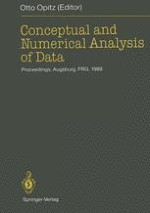1989 | OriginalPaper | Chapter
Least Squares Approximation of Additive Trees
Author : Werner Vach
Published in: Conceptual and Numerical Analysis of Data
Publisher: Springer Berlin Heidelberg
Included in: Professional Book Archive
Activate our intelligent search to find suitable subject content or patents.
Select sections of text to find matching patents with Artificial Intelligence. powered by
Select sections of text to find additional relevant content using AI-assisted search. powered by
Several authors have proposed procedures for fitting an additive tree to a distance, and some of them make use of the least squares principle, e.g. Sattath & Tversky (1977), Carroll & Pruzansky (1980) and de Soete (1983). However, a rigorous mathematical treatment of the underlying least squares approximation problem is missing. We start to fill this gap by considering the approximation problem for a fixed tree structure. We present a characterization of the unique solution based on the comparison of averages. Some conclusions from this characterization give a first insight to the general approximation problem with unknown tree structure. Let X be a finite set of objects. Following Buneman (1971), a tree structure on X can be represented by a system of compatible splits: Each edge of the tree structure is represented by a bipartition {A, Ac} of X, called a split, and two splits {A, Ac} and {B, BC} are called compatible, if A ⊆B ⋁ A ⊆ Bc ⋁ Ac ⊆ ⋁Ac ⊆ Bc holds (cp. fig. 1).
